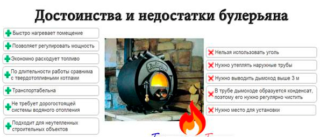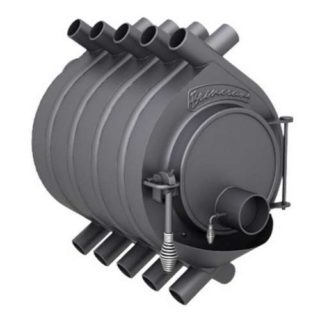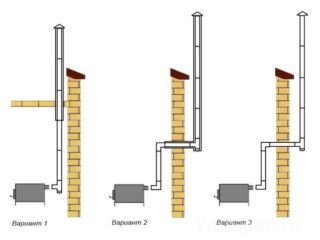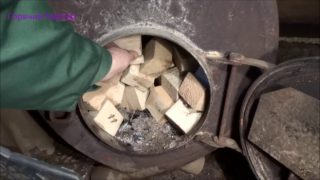Buleryan is a convection oven of long burning, reminiscent of a "potbelly stove" according to the principle of operation. The name of the design was given by a well-known brand, which in 1993 developed a highly economical, efficient heating device. It is used for heating residential, non-residential premises.
Description of the Buleryan furnace
The Buleryan furnace is a steel structure of a cylindrical shape with pipes hidden inside, bent in a special way. The third part of the tubes protrudes outward. The blower door with a rotary throttle closes tightly, creating increased tightness. The body is equipped with two combustion chambers and a slide gate at the outlet of the furnace, which regulates the traction.
The mechanism works on the principle of a classic potbelly stove, but at the same time it differs in some features. Cold air, passing through the internal pipes, is heated to the desired temperature and leaves the upper part. In one minute, the furnace is able to pass through itself up to 6 m3. The surface of the heater is heated to 50 ° C, which makes it safe to use.
The Buleryan stove is equipped with two fire chambers. The first smolders fuel and produces gases that move into the chimney, which is the second chamber, where they completely burn out. Such a combustion system makes the mechanism as economical as possible with optimal efficiency indicators of 80%. Due to smoldering, one full fuel tab is enough for 8 hours of continuous operation.
The main working materials are:
- peat;
- firewood;
- pellets;
- wood chips;
- briquettes and woodworking waste.
It is forbidden to use coal, which can lead to the burning of the housing.
Advantages and disadvantages
 The main advantage of a Buleryan type furnace is the minimum number of drawbacks that, with proper installation and operation, are almost invisible. Initially, the equipment was used by Canadian foresters working in the taiga. The device was easily transported, did not require constant attention and quickly warmed in cold weather.
The main advantage of a Buleryan type furnace is the minimum number of drawbacks that, with proper installation and operation, are almost invisible. Initially, the equipment was used by Canadian foresters working in the taiga. The device was easily transported, did not require constant attention and quickly warmed in cold weather.
Over time, the design became popular among a wide range of consumers, not only in Canada, but also far beyond its borders, thanks to such advantages:
- compact sizes, small weight - 50 kg;
- decent radius of heat distribution - 100 m3;
- low energy consumption with decent performance;
- no need to constantly add fuel to the furnace;
- acceptable price;
- ease of use, not requiring complex manipulations, qualifications.
The minuses of the Bullerjan furnace include:
- soot formation due to incomplete withdrawal of combustion products;
- unpleasant odor that occurs during kindling and in the process of decay of the dust structure deposited on the outer surface;
- the need for constant adjustment.
These disadvantages are not so significant in comparison with the advantages.
Stove chimney
When choosing a chimney for a Buleryan fireplace stove, it is important to consider the following indicators:
- the presence of thermal insulation;
- how convenient installation;
- lifetime;
- indicators of intensity and stability of traction.
An important factor is the material of manufacture:
- Brick. A popular option, which is better to install in a finished system, and not at the stage of building construction.
- Ceramic. Difficult to assemble, requiring the installation of protective blocks for ceramics, plaster, pipe lining. But at the same time, the chimney is resistant to temperature extremes and the appearance of condensate. It has a long service life of up to 50 years.
- From stainless steel.Quick, easy installation, during which it is necessary to take care of additional thermal insulation to protect the material from deformation during strong heating.
The chimney for the Buleryan furnace can be made by yourself. To do this, you must first stock up on everything you need and follow the instructions.
Installation location
Buleryan for heating with a water circuit is mounted in compliance with fire safety regulations in places with good air circulation. To evenly distribute heat, it is recommended to install the structure in a room located in the middle of the building at an equal distance from the heated rooms.
Buleryan boiler is used to organize the main or additional heating. In the first case, the equipment is suitable for houses with an area of not more than 70 m2, with 4-5 rooms. As an auxiliary source of heat, the device saves gas / electricity and helps maintain a comfortable temperature in severe frosts.
According to fire safety, the distance from the nearest facility to the front door should be at least 1.25 m, to elements with low flammability - 1 m, to non-combustible products - 0.7 m.
A boiler for a house or a furnace for a Buleryan bath is mounted on a special non-combustible stand made of metal, brick 20 cm high. The flooring in front of the door must also be made of non-combustible materials.
Firebox Features
Hardwood is used for the Buleryan furnace, coniferous wood quickly clogs the chimney, so this type of fuel is not recommended. Fruit varieties of trees give off minimal heat.
A chimney gate is opened in front of the firebox, the damper is blown. Firewood is burned through any kindling. After combustion has begun, the loading door is closed. Be sure to follow the process for 10-15 minutes to verify the correctness of the current process. Warm air begins to flow into the room quickly enough. If there is a strong draft in the furnace, a peculiar hum appears, at which it is recommended to slightly cover both shutters.
In addition to standard firewood, you can use:
- brown coal together with firewood - it is forbidden to heat only coal, this will greatly reduce the service life of the equipment;
- peat briquettes - the best option with perfect heat dissipation;
- tree bark, sawdust, wood chips - will help to save;
- pellets - pre-installation of the grid.
To reduce fuel consumption, it is necessary to insulate and regularly clean the chimney, lay only dry firewood from hardwood: oak, aspen, acacia.






